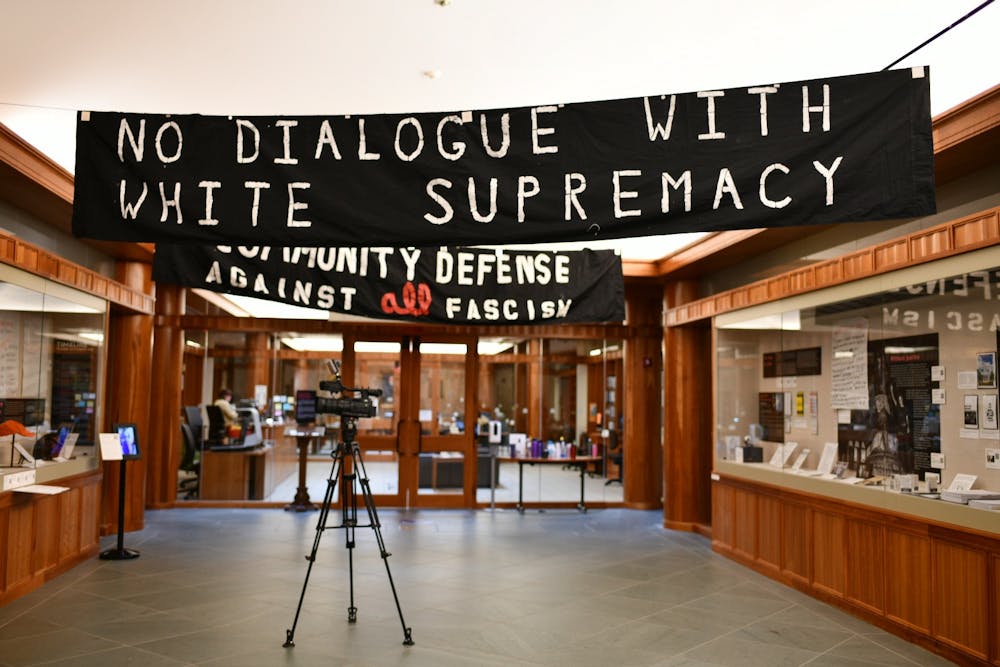The Albert and Shirley Small Special Collections Library is currently featuring an exhibit entitled “No Unity without Justice” exploring the community and student activist response to the events of August 2017. The exhibit opened Aug. 8 and will remain open through Oct. 29, and is displayed on the first floor of the Special Collections Library. It features artifacts and stories collected by students, community members and staff.
Library staff expressed their belief in truth and justice, as well as solidarity with the Memory Project, an initiative aimed at researching and addressing issues associated with public memory following the “Unite the Right” rally.
“The students and faculty whose experience is represented in this exhibition put themselves in harm’s way to resist fascism and white supremacy, which were nakedly and undeniably on display in Charlottesville in August of 2017,” Dean of Librarians John Unsworth wrote. “We owe them a debt of gratitude.”
Among the artifacts are the possessions of activists who were present in Charlottesville Aug. 11 and 12. Visitors can scan QR codes which accompany these artifacts to read articles, first-hand stories and other documents surrounding the events of Aug. 11 and 12.
The exhibit was primarily curated by 2018 College alumna and activist Kendall King who was present at the protest Aug. 11 and experienced the violence of the event firsthand.
Two pieces of artwork – a paper collage poster created by 2020 College alumna and curator Hannah Russell-Hunter and an acrylic painting by 2020 College alumna and activist, Natalie Romero – are on display at the exhibit. The artworks offer a look into how the process of curation and artistry allow individuals to reflect on their experiences.
“The curators of this exhibit are not only activists, community organizers, and survivors of the Summer of Hate, but also educators, scholars, and artists,” the caption for the two artworks reads. “In revisiting their experiences, the process of curation to share their story with a broad audience has been healing.”
According to Jalane Schmidt, associate professor of religious studies and director of the Memory Project, the idea for this exhibit has been in the works for several years. It was first conceptualized by King and other student survivors when they were still studying at the University.
The idea came to fruition when Schmidt began to consider possibilities for honoring the fifth anniversary of the riots. Schmidt reached out to King and the project moved quickly as King collaborated with other alumni activists to create the display.
In addition to featuring artifacts and stories from the “Unite the Right” rally and counter-protests, the exhibit also includes information about the long history of student activism at the University. This history includes the creation of the U.Va. Black Students for Freedom organization in 1969 and May Day, anti-war protests of the 1970s.
“Something that's celebrated in the exhibit too is all the struggle that went into student activism over the years — it wasn't just these kids on that particular day, during the summer of hate,” Schmidt said. “[These students] see themselves as part of years of [activists] organizing at the University.”
The exhibit also sheds light onto the contentious interactions between activists and University administrators including Teresa Sullivan, the University president at the time who discouraged students from engaging in counter-protests.
A video on display in the exhibit shows a confrontation between students and Sullivan, in which Sullivan claims “we didn’t know they were coming.”
The video is coupled with a QR code leading to an exposé which states that Sullivan and University administration were ill-prepared for the violence unleashed on Grounds. According to the exposé, this unpreparedness manifested in University police being unaware of their ability to extinguish open flames, officers employing tactics typical for nonviolent protests and held back from the crowd even as rioters surrounded counter protesters.
For Schmidt, this particular video is important because it displays how student activists continued to stand by their decision to protest even after the riots ended.
“I think that what will show in this exhibit is the measure of these students and of their moral fortitude to stand up and to [protest] even when there was a lot of pressure to not stand up.” Schmidt said. “Not only standing up against the pressure and then standing up literally against the violent blows of fascist[s] but then afterwards being further marginalized and gaslit by the administration.”
Poster throughout the exhibit provide contextual information relating to the artifacts on display. One expresses activist’s feelings of disappointment in the University’s response which according to the exhibit included claiming that protestors were defending the Jefferson statue.
“Activists present that evening embodied their shared principle of ‘no platform for white supremacy’ with no intention of defending the institution,” the billboard reads. “They came to protect fellow students and continue their work against white supremacy.”
In addition to honoring student activists, the exhibit also allows visitors to see the connections between the “Unite the Right” rally of 2017 and events such as the January 6 attack on the Capitol.
According to Schmidt, the Charlottesville riots acted as an early indicator that the groups who enacted violence in Charlottesville still play a role in both local and national discourse.
“I think it's important to reflect on it after five years, and to see where our experience, our trauma that happened here fits in with a larger national narrative that's been shaping up since then, with some of the same actors and some of the same tactics being used,” Schmidt said.







